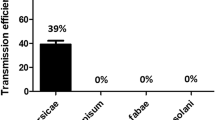Summary.
Maize yellow stripe virus (MYSV) has several features in common with tenuiviruses, but is transmitted by a leafhopper, Cicadulina chinai (Cicadellidae, Hemiptera), rather than planthoppers (Delphacidae, Hemiptera). Herein, MYSV was shown to be propagatively transmitted like tenuiviruses. MYSV RNA was not detected in leafhoppers by dot blot hybridization one day following a 2-day acquisition access period (AAP), but was detected in single or groups of leafhoppers 5–20 days post-acquisition. Likewise, capsid protein of MYSV was not detected by ELISA in single leafhoppers until the third day after the beginning of a 1- or 3-day AAP, but subsequently, mean absorbance values (405 nm) increased gradually, reaching their highest levels 8–14 days post-acquisition. The percentage of ELISA-positive leafhoppers also increased during the same period. Unlike most tenuiviruses, transovarial transmission of MYSV was not detected in 600 C. chinai nymphs that hatched from eggs laid by females that had acquired MYSV from diseased plants. The implications of our findings for MYSV classification are discussed.
Similar content being viewed by others
References
Ammar ED, Elnagar S, Tolba A, Aboul-Ata AE (1984) Three maize diseases in Egypt associated with leafhoppers (Cicadellidae, Homoptera). In: 6th Congress of the Mediterranean Phytopatholological Union, Cairo, Egypt
ED Ammar AE Abul-Ata MA El-Sheikh GH Sewify (1987) ArticleTitleIncidence of virus and virus-like disease syndromes on maize and sugarcane in Middle and Lower Egypt Egypt J Phytopath 19 97–107
ED Ammar S Elnagar AE Aboul-Ata GH Sewify (1989) ArticleTitleVector and host plant relationships of the leafhopper-borne maize yellow stripe virus J Phytopathol 126 246–252
ED Ammar RE Gingery DT Gordon AE Aboul-Ata (1990) ArticleTitleTubular helical structures and fine filaments associated with the leafhopper-borne maize yellow stripe virus Phytopathology 80 303–309
ED Ammar LR Nault (2002) Virus transmission by leafhoppers, planthoppers and treehoppers (Auchenorrhyncha, Homoptera) RT Plumb JA Callow (Eds) Advances in botanical research NumberInSeries36 Academic Press London 141–167 Occurrence Handle10.1016/S0065-2296(02)36062-2
ED Ammar M Peterschmitt (2004) Maize yellow stripe H Lapierre P-A Signoret (Eds) Viruses and virus diseases of Poaceae (Gramineae) EditionNumberINRA Editions Versailles France 682–685
MI Boulton PG Markham (1986) The use of squash-blotting to detect plant pathogens in insect vectors RAC Jones L Torrance (Eds) Developments and applications in virus testing SeriesTitleAssociation of Applied Biologists The Lavenham UK 55–69
CC Chen RJ Chiu (1989) ArticleTitleTransmission of rice wilted stunt virus by the planthopper Nilaparvata lugens Bulletin of Taichung District Agricultural Improvement Station 23 3–10
BW Falk JH Tsai SA Lommel (1987) ArticleTitleDifferences in levels of detection for the maize stripe virus capsid and major non capsid proteins in plant and insect hosts J Gen Virol 68 1801–1811 Occurrence Handle1:CAS:528:DyaL2sXkvFehsL8%3D Occurrence Handle10.1099/0022-1317-68-7-1801
BW Falk JH Tsai (1998) ArticleTitleBiology and molecular biology of viruses in the genus Tenuivirus Ann Rev Phytopathol 36 139–163 Occurrence Handle10.1146/annurev.phyto.36.1.139 Occurrence Handle1:CAS:528:DyaK1cXmtlamtL0%3D
RE Gingery (1988) The rice stripe virus group RG Milne (Eds) The plant viruses NumberInSeries4 Plenum Press New York 297–329
Injante-Silva PH, Munoz JL, Mihm JA (1997) Selection methodology for resistance to Dalbulus maidis and fine stripe virus disease in maize in Peru. In: International Symposium at the International Maize and Wheat Improvement Center. Insect resistant Maize: Recent advances and utilization. Mexico, pp 287–289
P Jones J Qiu D Rickwood (1994) RNA isolation and analysis BIOS Scientific Publishers Oxford
Khalifa EA (1994) Role of the leafhopper Cicadulina chinai (Ghauri) (Cicadellidae: Homoptera) as a vector of maize yellow stripe virus. MSc Thesis, Faculty of Agriculture, Cairo University, Giza, Egypt, pp 68
Mahmoud A (1994) Characterization and serology of the leafhopper-borne maize yellow stripe virus in Egypt. MSc Thesis, Faculty of Agriculture, Cairo University, Giza, Egypt, pp 75
A Mahmoud J-C Thouvenel SE Abol-Ela GH Sewify ED Ammar (1996) ArticleTitleDetection of maize yellow stripe tenui-like virus by ELISA and dot-blot tests in host plants and leafhopper vector in Egypt Phytopath Medit 35 19–23
Mahmoud A (2001) Biological and molecular characteristics of maize yellow stripe virus and its relationship with the leafhopper vector. PhD, Thesis, Faculty of Agriculture. Cairo University, Giza, Egypt, pp 156
T Nagata AK Inoue-Nagata J van Lent R Goldbach D Peters (2002) ArticleTitleFactors determining vector competence and specificity for transmission of Tomato spotted wilt virus J Gen Virol 83 663–671 Occurrence Handle11842261
LR Nault DT Gordon (1988) ArticleTitleMultiplication of maize stripe virus in Peregrinus maidis Phytopathology 78 991–995
LR Nault (1997) ArticleTitleArthropod transmission of plant viruses: a new synthesis Ann Entomol Soc Am 90 521–541
GH Sewify (1994) ArticleTitleGraminaceous weeds as reservoirs for the leafhopper borne maize yellow stripe virus (MYSV) and its vector Cicadulina chinai Ghauri Egypt Bull Fac Agric Univ Cairo 45 515–524
Urbina AR, Mihm JA (1997) Improving two tropical maize populations for resistance to stunt complex. In: International Symposium at the International Maize and Wheat Improvement Center. Insect resistant Maize: Recent advances and utilization, Mexico, pp 139–142
Van Regenmortel MHV, Fauquet CM, Bishop DHL, Carstens EB, Estes MK, Lemon SM, Maniloff J, Mayo MA, McGeoch DJ, Pringle CR, Wickner RB (2000) Virus taxonomy. Classification and nomenclature of viruses. Seventh Report of the International Committee on Taxonomy of Viruses. Academic Press, San Diego
Author information
Authors and Affiliations
Rights and permissions
About this article
Cite this article
Ammar, ED., Khlifa, E., Mahmoud, A. et al. Evidence for multiplication of the leafhopper-borne maize yellow stripe virus in its vector using ELISA and dot-blot hybridization. Arch Virol 152, 489–494 (2007). https://doi.org/10.1007/s00705-006-0877-x
Received:
Accepted:
Published:
Issue Date:
DOI: https://doi.org/10.1007/s00705-006-0877-x




